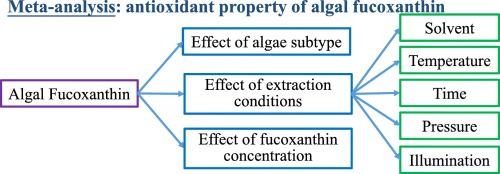Algal Research ( IF 4.6 ) Pub Date : 2020-12-18 , DOI: 10.1016/j.algal.2020.102161 Shuang Qiu , Yeting Shen , Zhengshuai Wu , Xingchen Zhang , Shijian Ge

|
Algal fucoxanthin as a carotenoid pigment possesses various health benefits, among which, the antioxidant property is one of the most explored. Current research indicated that algal fucoxanthin is generally extracted from different subtypes (micro- and macro-algae) under varying extraction conditions. However, it lacks information whether algae subtypes and extraction conditions present a remarkable impact on the antioxidant property of the extracted fucoxanthin. In this study, the effects of algae subtype and extraction condition (i.e., extraction solvents, temperature, time, pressure and illumination condition) on fucoxanthin antioxidant property were investigated by performing a meta-analysis. The subtotal standard mean difference (SMD) of the microalgae and macroalgae subtypes were 12.59 (95% confidence interval (CI): 3.63–21.56) and 7.20 (3.44–10.96), respectively, presenting an overlapping range. This suggested that no statistically significant differences existed in the fucoxanthin antioxidant property extracted from two subtypes, which was consistent with the results from the subgroup analysis and meta-regression. Similar observations were found for algal fucoxanthin extracted by alcohols (SMD (CI):7.18 (3.36–11.00)) or alkanes (SMD (CI):11.88 (3.62–20.15)). Moreover, the employed extraction conditions including extraction time (SMD (CI) for “≥60 min” vs “<60 min”: 8.03 (3.55–12.50) and 7.97 (2.49–13.45)), pressure (SMD (CI) for normal vs pressurized: 7.68 (4.00–11.35) and 10.64 (0.21–21.03)), and illumination (SMD (CI) for dark vs normal: 6.91 (2.31–11.50) and 9.45 (4.17–14.73)) showed no statistical influence on fucoxanthin antioxidant property. However, extraction at higher temperature produced stronger fucoxanthin antioxidant property (SMD (CI) for room temperature vs “≥40 °C”: 31.43 (12.27–50.59) and 7.21 (3.69–10.74)). Additionally, the fucoxanthin antioxidant property exhibited a positive concentration-dependent correlation according to meta-regression analysis. Our findings provide suggestions for fucoxanthin extraction from algae under various conditions and give insights to its application as an antioxidant. As more data become available in the future, data analysis could be updated for more robust comparisons.
中文翻译:

藻类亚型和提取条件对提取的岩藻黄质抗氧化性能的影响:20年荟萃分析
藻类黄嘌呤类胡萝卜素作为一种类胡萝卜素颜料具有多种健康益处,其中抗氧化性是最受关注的一种。当前的研究表明,藻类黄嘌呤通常在不同的提取条件下从不同的亚型(微藻和大藻)中提取。然而,它缺乏关于藻类亚型和提取条件是否对提取的岩藻黄质的抗氧化性能产生显着影响的信息。在这项研究中,通过进行荟萃分析,研究了藻类亚型和提取条件(即提取溶剂,温度,时间,压力和光照条件)对岩藻黄质抗氧化性能的影响。微藻和大藻亚型的小计标准平均差(SMD)分别为12.59(95%置信区间(CI):3.63–21.56)和7.20(3)。44–10.96),分别显示了一个重叠范围。这表明从两个亚型中提取的岩藻黄质抗氧化特性没有统计学上的显着差异,这与亚组分析和荟萃回归的结果一致。对于用醇(SMD(CI):7.18(3.36-11.00))或烷烃(SMD(CI):11.88(3.62-20.15))提取的藻类黄嘌呤,也发现了类似的观察结果。此外,采用的萃取条件包括萃取时间(“≥60分钟”的SMD(CI)与“ <60分钟”的萃取时间:8.03(3.55-12.50)和7.97(2.49-13.45)),压力(正常条件下的SMD(CI))相对于加压:7.68(4.00–11.35)和10.64(0.21–21.03)),照度(黑暗与正常的SMD(CI):6.91(2.31–11.50)和9.45(4.17–14.73))对岩藻黄质没有统计学影响抗氧化性能。然而,在较高的温度下萃取可产生更强的岩藻黄质抗氧化性能(室温对“≥40°C”的SMD(CI):31.43(12.27-50.59)和7.21(3.69-10.74))。此外,根据meta-回归分析,岩藻黄质的抗氧化性能表现出正浓度依赖性。我们的发现为在各种条件下从藻类中提取岩藻黄质提供了建议,并为其作为抗氧化剂的应用提供了见识。随着将来有更多数据可用,可以更新数据分析以进行更可靠的比较。根据荟萃回归分析,岩藻黄质的抗氧化性能呈浓度依赖性正相关。我们的发现为在各种条件下从藻类中提取岩藻黄质提供了建议,并为其作为抗氧化剂的应用提供了见识。随着将来有更多数据可用,可以更新数据分析以进行更可靠的比较。根据荟萃回归分析,岩藻黄质的抗氧化性能呈浓度依赖性正相关。我们的发现为在各种条件下从藻类中提取岩藻黄质提供了建议,并为其作为抗氧化剂的应用提供了见识。随着将来有更多数据可用,可以更新数据分析以进行更可靠的比较。











































 京公网安备 11010802027423号
京公网安备 11010802027423号